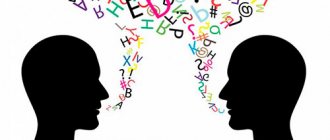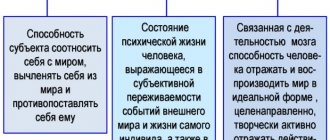Speech as the basic mental concept of its properties and functions
Tatiana Birulina
Speech as the basic mental concept of its properties and functions
Speech as a basic mental concept , its properties and functions
Speech between people using language constructs, the creation of which contains certain rules.
It should be noted that this concept is studied in the context of several disciplines, so there is no clearly formulated and final interpretation of it. Linguists interpret this word more narrowly: speech is a person’s knowledge and ability to use natural language. In general psychology, speech is a way of expressing and communicating to other people one’s internal, psychological states , thoughts and feelings. Speech also includes non-verbal means of communication: gestures, facial expressions, pantomime and other various means of exchanging information.
Speech is an integral element of human activity. Thanks to speech, a person learns about the world around him, shares his experience and knowledge with other people, both his own and subsequent generations. It is speech determines the mechanism for the development of thinking.
According to I.P. Pavlov, speech is a distinctive feature of human thinking, since it provides an opportunity to escape from reality and generalization.
Speaking (both oral and written)
has a number of characteristic features, including:
1) content, which consists in the number of thoughts, images and feelings expressed in speech, their significance and correspondence to reality;
2) clarity , achieved by syntactically correct construction of sentences, using pauses and logical stress when necessary to highlight words;
3) expressiveness - emotional richness, brightness, energy of speech, variety and richness of linguistic means;
4) effectiveness - the influence of speech on the behavior and beliefs of other people, their thoughts, feelings and will.
Forms of speech are “standard methods of structural and semantic organization of speech utterances based on the corresponding use of linguistic means of constructing speech messages.”
In the general structure of speech activity, there are three forms: external oral, external written and internal speech .
It should be noted that in general psychology and special pedagogy forms of speech are classified differently, depending on the criteria considered.
Based on the nature of the means of expressing thoughts used, oral speech (implemented by sound means), kinetic speech (includes expressive gestures and postures, most often used in conjunction with other forms of speech) and written speech are .
external speech differs (audible, articulated, hidden speech ( “to oneself”
, inner
speech (collapsed and predominantly predicative)
.
According to the degree of activity of the individual in planning and producing speech activity, speech is divided into active (planned completely independently), reactive (the interlocutor-partner partially and indirectly takes part in planning) and automated (with a complete absence of planning)
.
Researchers have identified several main functions performed by speech .
1. Communicative - the main function of speech , manifested in the transfer of information from one person to another or a group of people. There is an exchange of words that are perceived as separate concepts containing certain knowledge.
This function implies that people use speech in various types of joint activities as an organizing tool.
The communicative function of speech is divided into two subfunctions : messages, when a person expresses his opinion on any problem or characterizes his attitude towards any subject, and incentives to action, the effectiveness of which depends on the emotional expressiveness of speech.
2. The regulatory function of speech (was identified by L. S. Vygotsky and studied by A. R. Luria and other psychologists ) is realized in conscious forms mental activity - the so-called higher mental functions , which are voluntary. This function is manifested in the fact that people use speech to regulate the behavior of other people, as well as to master their own behavior, applying the same stimulus-signs to it. It is thanks to inner speech that a person is able to master his voluntary actions.
3. The programming function of speech consists in “constructing semantic schemes of a speech utterance, grammatical structures of sentences, in the transition from an idea to an external, detailed utterance. is based on internal programming, carried out using internal speech. As clinical data show, it is necessary not only for speech expression, but also for constructing a wide variety of movements and actions.”
Speech is closely integrated with all human mental processes ; it is language in action.
Concept and properties
The psychology of speech has been studied since the birth of a person. Some people confuse this concept with language, but they are two different terms.
Psychologists distinguish several interpretations of the concept of speech:
- ability, ability of a person to speak;
- an action that a person performs with the help of sounds;
- technology for expressing thoughts through language skills.
Language is a complex, original system of signs with which information can be transmitted orally or in writing.
Properties of speech:
- Understandability is determined by the totality of information and knowledge. To understand another person, you need to understand the terminology and know the specifics of the topic of conversation.
- Content - the number of expressed feelings, thoughts, aspirations in a conversation. Speech can be meaningful or superficial. For the first option, a conversation between two specialists regarding a topic of interest to them is relevant; for the second, an ordinary conversation between two acquaintances on topics that do not arouse strong interest.
- Expressiveness is a property associated with emotional richness. Speech can be energetic, bright, rich or empty, pale, sluggish.
Another property is impact. With the help of beliefs, requests, commands, and other methods, you can motivate a person to action.
Types of speech disorders in children and adults
In speech therapy, several basic typifications are accepted - based on similar manifestations and sources. This helps to understand in which direction to look for the source of the problem and ways to correct speech impairment. Clinical and pedagogical classification
- Rhythm and tempo disorders: Stuttering (a deviation known since time immemorial. According to historians, the ancient Greek orator Demosthenes once suffered from a stutter, but persistently practiced making speeches by stuffing his mouth with small pebbles. Having learned to speak clearly with stones in his mouth, he developed an excellent articulation and self-confidence, thereby getting rid of the disease. Speech therapists still practice this method of correcting speech disorders).
- Dyslalia (in oral speech the child incorrectly pronounces or distorts individual sounds).
- Dysarthria (organs of articulation (lips, tongue) have critical limitations in mobility).
- Rhinolalia (reduced resonance in the nasal cavity).
- Other articulation disorders: polternium, tachylalia, bradyllalia.
- Aphonia (loss of a clear voice, a person speaks in a whisper. Problem with the vocal cords).
- Structural-semantic disorders: alalia (occurs during childbirth when the speech areas of the brain are damaged. At the same time, the child is fine with intelligence and hearing), aphasia (a similar problem. Organic lesions of the areas of the cerebral cortex that are responsible for controlling speech , and the adjacent “subcortex". It differs from alalia in that it is not a congenital phenomenon, but an acquired one - in people who can already speak. Usually occurs as a result of a stroke in adults).
- Dyslexia (difficulty perceiving written text, mixing sounds and words when reading, inability to form letters into ready-made words).
Psychological and pedagogical classification of speech disorders
- violations in the use of communication means stuttering
- other complications
- phonetic-phonemic speech underdevelopment
Functions
When researchers began to study the role of speech in society, they identified two functions of this ability - intellectual and communicative.
Intelligent
Speech acts as a means of education, development, and expression of thoughts. The unit of thinking and speech is the word. Each of them has its own meaning.
Communication
Speech is a tool of communication between people, allowing them to exchange information and encourage action. When creating messages, a person indicates a phenomenon or object in it. To evoke emotions in your interlocutor, you need to form the correct meaning.
The main purpose of verbal meanings is to convey thoughts. This is influenced by the choice of word, the emotional expression that relates to the sounds being spoken.
With the help of tone, facial expressions, intonation, imagery of expressions, selection of words, expression of feelings, you can express a thought. These techniques will help make the message more expressive, rich or faded and empty.
History of the study and researchers
It is believed that the first articulate speech appeared about two million years ago. Then the first people developed a speech apparatus.
Psycholinguistics is a branch of psychological science that was formed under the influence of linguistics. Its goal is to study the relationships between consciousness, thinking, and language.
The term “speech” was proposed by the famous American psychologist J.R. Cantor. It became widely used among other researchers after Kantor’s student N. G. Pronko used it in the article “Language and Psycholinguistics.”
One of the main hypotheses that played a huge role in the formation and development of psycholinguistics is the hypothesis of linguistic relativity. After its publication, the scientific world began to actively raise the question of the relationship between thinking and language.
The next scientist who made a huge contribution to the study of speech was N. Chomsky. In his works, he described the work of language when constructing phrases and sentences.
The domestic psychologist who made a great contribution to the development of this direction of psychological science is L. S. Vygotsky. He formed a sequence of actions before reproducing the words. It consists of several elements:
- motivation;
- formation of thoughts;
- internal construction of the sentence;
- choice of words;
- implementation.
Prevention of speech disorders. Helping a child at home
To prevent violations and for the general development of speech, constant communication is needed. Otherwise, problems will arise sooner or later, even if there were no medical prerequisites initially. A child learning a language must practice through regular contact with native speakers. And the carriers are you. Communication is an integral part of the education program.
What's useful:
- read together with your child, talk about what you read, illustrate the plot together, discuss the drawings;
- sing songs together;
- listen to the little why, without interrupting, answer his questions about the world around him, teach him to listen to others;
- correct errors in the pronunciation of words and sounds, find the correct analogues for “baby” words and “lisping” (“bobo”, “kaka”).
Mistakes that many people make, but I want to believe you don’t:
- the child’s questions are answered with the general “when you grow up, you’ll know” and “because it ends in U”;
- do little socializing and reading aloud; so that the child is not distracted from his work, they turn on cartoons for the whole day and leave him alone with the TV or computer;
- They repeat with tenderness after the baby everything that he babbles, thereby contributing to the reinforcement of incorrect words and illiterate pronunciation - they impoverish the speech of the future native speaker of the Russian language.
From a “technical” point of view, breathing exercises and tongue exercises are always beneficial. Breathing can be trained using play methods that are interesting to the child: blowing soap bubbles and balloons, learning to play toy flutes and harmonicas. There are standard articulation exercises for practicing various problem sounds, when the tongue, lips and teeth are held for 10-20 seconds in certain positions:
- sound “R” - mouth wide open, tongue at the upper jaw, tapping on the teeth while pronouncing the sound “D”;
- hissing - the lips are extended forward as much as possible, the jaws are closed;
- whistling - the end of the tongue rests against the front teeth of the lower jaw, and the edges against the far teeth of the upper jaw.
When we are talking not about prevention, but about the correction of already established deviations, the work is carried out more deeply, according to individual programs, with the regular participation of a speech therapist. If your child has clear signs of a speech disorder, but you cannot understand the reasons and what to do next, we suggest that you undergo a comprehensive diagnosis of speech disorders at our Center. To make an appointment for an examination and an appointment with a speech therapist, call tel. or use the online registration form on the website e.
Stages of development and formation of speech in a child
The skills and inclinations of a normally developing child directly depend on his age. But even in infants, experts are able to predict speech disorders in the future based on some signs. If motor development in the first year of life lags behind the norm, this is a possible sign that speech and mental development will also lag behind. We would also like to note that development standards were established in Soviet times and were quite strict. Now, unfortunately, many modern children do not meet them. Children of the new generation speak less and their speech takes longer to develop. The reasons for this are global “gadgetization” and the transition of people to virtual methods of communication.
| Age | Skills |
| up to 6 months |
|
| 6-9 months |
|
| 9 months-1 year |
|
| 1-1.5 years |
|
| 1.5-2 years |
|
| 2-3 years |
|
| 3-5 years |
|
Experts recommend regular examinations to identify delays, if any, as early as possible. One child is one of those who “harnesses slowly and rushes quickly.” He will start speaking later, but within a month he will catch up and surpass his peers. Then consider yourself lucky. But for another child, prolonged silence may hide such gloomy diagnoses as autism spectrum disorder, alalia and others. And it is very important not to miss them and start correction on time.
If you have any doubts about whether your child’s development rate is within the normal range, it is better to visit a specialist. What if he has a general
speech disorder
(general speech underdevelopment - GSD) or delayed speech development (SDD)?
For a child with severe speech impairment
It is often difficult to perceive the world around us positively. He grows up as a gloomy beech, touchy and aggressive, feels insecure, and with age begins to feel his inferiority. You can read more about the symptoms and degrees of speech underdevelopment here. Consult with specialists! Both minor and more significant speech deviations are usually identified in the first few years of life as a result of comprehensive diagnostics.
The spheres and areas of responsibility of specialists in speech problems are distributed as follows:
- Speech therapist
: Consults from 1.5 years old, conducts classes from 2 years old. At the consultation, he makes a final diagnosis, if it is a disease, and refers to a neurologist if there are suspicions of disorders of a corresponding nature; - Speech pathologist
: works with non-speaking children; in case of delays in psycho-speech development and pre-speech diseases (alalia, autism spectrum disorder), it helps to “start” speech and develop other cognitive functions to the level of the age norm.
We are primarily talking about young children. also occur in adults
- due to a brain injury or stroke.
Their correction is carried out by speech therapists and aphasiologists. Sometimes speech impairment in schoolchildren
and adults remains from neglected/undertreated pronunciation defects in childhood.
Kinds
The ability is oral and written. These tools allow you to express the thought that an individual has formed.
Oral
A communication tool, when activated, a person pronounces words and perceives verbal messages from others by ear.
There are two types:
- Monologue is a type of speech that does not require interlocutors to express it. One person says something, others listen. More often, thoughts conveyed through a monologue are more detailed.
- Dialogical - used when talking between different people. Characterized by situationality and incomplete deployment.
A huge role in dialogue is given to facial expressions, gestures, intonation, emotional background, and other non-verbal means of communication.
Written
It is realized using various forms that are accessible to visual perception. It is fixed to some material (usually a sheet of paper).
This speech cannot be called living or belonging to a person. It is impersonal because there is a gap between its formation and presentation to the reader.









